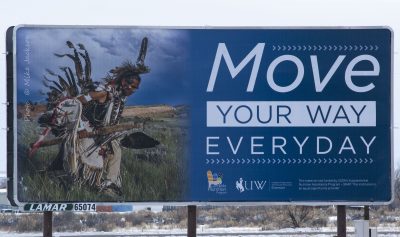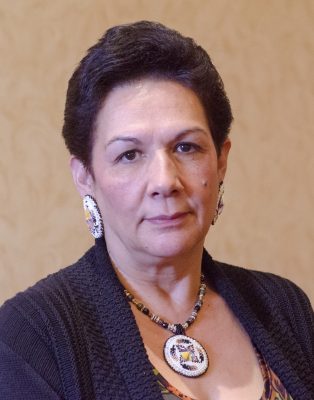Two billboards featuring a Native American in full traditional dance regalia is helping send a culture-specific message of the importance of health and physical activity to residents of the Wind River Indian Reservation.
The billboards, one just south of Riverton and the other near Lander, depict John Pingree in a traditional dance with the message “More Your Way Every Day.”

The billboards, a project of the Cent$ible Nutrition Program in the University of Wyoming Extension, went up in January and are expected to be taken down this month, said Kelly Pingree, extension educator on the WRIR. CNP is a free, income-qualifying, cooking and nutrition education program in Wyoming that can help people cook and eat better for less money.
Kelly said the billboards are an effort to raise overall health on the WRIR.
“We have such a pandemic of obesity, diabetes and heart disease, and that’s on pretty much any reservation,” she said. “Since we’ve gotten colonized more than 180 years ago, our lives have gotten more sedentary. There is really not a lot of moving about or having to work and hunt and gather like we used to.”
Pingree started with CNP, a program in the College of Agriculture and Natural Resources, in 2016. Billie Spoonhunter recently joined her in the CNP office on the WRIR.
“The ability to engage with local partners for community changes, in addition to direct education, has opened up ways to increase health impacts on the Wind River Indian Reservation,” said Mindy Meuli, CNP director. “Due to their community connections, Kelly and Billie have been a great asset to CNP.”
Pingree said she saw the health of the WRIR in a new light when she joined CNP.
“It really opened my eyes to how big of a problem we do have on the reservation,” she said. “I think a lot of Indian communities have really woken up about that. There is serious talk about how we are going to change that. What are some of the ideas to change this, to start getting our people more healthy?”

The average life expectancy of Native Americans in Fremont County is about 55, according to information from Wyoming Vital Statistics inIn the Heart of Wyoming is Indian Country: Home to the Eastern Shoshone and Northern Arapaho Tribes Rich with Beauty, Spirituality, Families and Tradition published in 2016. That compares to about 69 in the general population of the county and 71 in the general population of Wyoming.
The billboard idea began two years ago when, as a CNP member, Pingree joined a reservation group concerned about health and fitness. There were a few billboards on the reservation showing the culture and native ways.
“I brought up the idea of using the billboards to introducing CNP that way, by putting something cultural out there for people to see,” she said. “Since our people are more physical and visual, I thought it was a very good way to get out who we are and what we are doing out here.”
Meuli and marketing coordinator Kali McCrackin Goodenough agreed. McCrackin Goodenough, Meuli, and Pingree developed the message and started to work on the design.
“Native people relate to anything dealing with native,” said Pingree. “We had to have some sort of cultural or physical activity up there they can relate to.”
Pingree thought of the photograph of her husband taken by photographer Mike Jackson of Best of the Tetons in Jackson Hole. The photograph had been taken near their home and featured in Cowboys and Indians magazine.
“When Kelly showed me the photo, I thought, ‘This is perfect!’,” McCrackin Goodenough said. “I love that the photo was taken on the Wind River Indian Reservation and that it features someone many people know.”
The message and billboard design were shown to CNP participants prior to the billboards going up. McCrackin Goodenough said the feedback was positive, and CNP went ahead.
“Any native will understand that message – traditional dancing and moving in our cultural way,” said Pingree. “Dance regalia is one of the most powerful symbols of his or her native identity. In that regard, it can be considered sacred.”
Many outfits could be several generations old and of family design.
Pingree said she believes community reaction has been good, and the CNP logo and message are becoming more recognized.
“I have had people come up and recognize John, and then some people who don’t,” she said. “And they see the CNP symbol up there. A lot of the community has taken notice we are trying to get healthy and physical. That’s also a U.S.-wide initiative. We are starting working getting us more healthy.”





